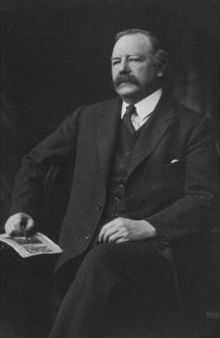Arthur Pillans Laurie
| Arthur Pillans Laurie | |
|---|---|
 | |
| Born |
6 November 1861 Edinburgh |
| Died | 1949 |
| Residence | London |
| Nationality | Scottish |
| Fields | Chemistry, Analysis of paintings |
| Institutions | Royal College of Arts |
| Alma mater | Cambridge University |
| Known for | Infra-red photography of paintings |
| Influences | William Holman Hunt |
Arthur Pillans Laurie (1861-1949) was a Scottish chemist who pioneered the scientific analysis of paintings.
Biography
Laurie was educated at Edinburgh Academy, the University of Edinburgh and then King's College, Cambridge, where he took a first in science in 1884.[1]
The pre-Raphaelite painter William Holman Hunt interested Laurie in the chemistry of paint and the scientific analysis of paintings. Laurie pioneered the use of chemical analysis to discover the composition of artworks, and so to show their true age and origins. He was the first to use infra-red photography to reveal deeper layers of paint. Through infra-red work, he found the date of a Rembrandt self-portrait where the date painted by the artist had later been covered up.[1]
In 1895 Laurie became a lecturer at St Mary's Hospital Medical School, and joined the Royal Commission on Secondary Education.[1]
In 1898 the Royal College of Physicians made him an examiner in chemistry.[1]
In 1900, Laurie became the principal of Heriot-Watt College, Edinburgh. He held this position until 1928.[1]
In 1912 Laurie became the professor of chemistry to the Royal Academy of Arts.[1]
In 1929 he stood as a candidate for parliament at the General Election in the constituency of Edinburgh South for the Liberal party, finishing second.
Laurie became a fellow of the Royal Society of Edinburgh (RSE).[2]
In 1939 Laurie wrote the notorious The Case for Germany, (1939). A pro-Nazi, anti-semitic work which praises Hitler's Germany. The book commences with praising Hitler as a painter and then expounds National Socialism. He continues with a defence of Nazism as he experienced it during his stay in Germany and criticizes the Jewish people and Marxist socialism.
Publications
Among Laurie's many technical writings are the following.[1]
- The Food of Plants, (1893)
- Facts About Processes, Pigments, and Vehicles - a Manual for Art Students, (1895)
- Greek and Roman Methods of Painting, (1910)
- The Materials of the Painter's Craft in Europe and Egypt, from the Earliest Times to the End of the XVIIth Century, (1910)
- The Pigments and Mediums of the Old Masters, (1914)
- The Painter's Methods and Materials, (1926)
- A Study of Rembrandt and the Painting of his School, (1929)
- The Brush Work of Rembrandt and his School, (1932)
- Pictures and Politics, (1934)
- New Light on Old Masters, (1935)
- The Case for Germany, (1939)
Family
His father was the educator Simon Somerville Laurie. He was the brother of zoologist Malcolm Laurie (1866-1932), both of whom were also fellows of the RSE.[2]
References
- ↑ 1.0 1.1 1.2 1.3 1.4 1.5 1.6 "Arthur Pillans Laurie". Biographical Information. NAHSTE (Navigational Aids for the History of Science, Technology & the Environment). Retrieved 9 October 2012.
- ↑ 2.0 2.1 "Former Fellows of the Royal Society of Edinburgh 1783-2002". Biographical Index, Part Two. Royal Society of Edinburgh. July 2006. Retrieved 8 October 2012.
Bibliography
- Year Book of the Royal Society of Edinburgh 1950 (Session 1948-1949), Oliver and Boyd, Edinburgh, 1951.
- Who's Who 1938, A&C Black, London, 1937.
- Rawlins, FIG; Hartley, Harold; Farmer, RC; Stacey, M. (1950). "Obituary notices: Arthur Pillans Laurie, 1861–1949; Sir Henry Miers, 1858–1942; Sir Robert Robertson, 1869–1949; F. E. Whitmore, 1923–1949". Journal of the Chemical Society (0): 429–441.